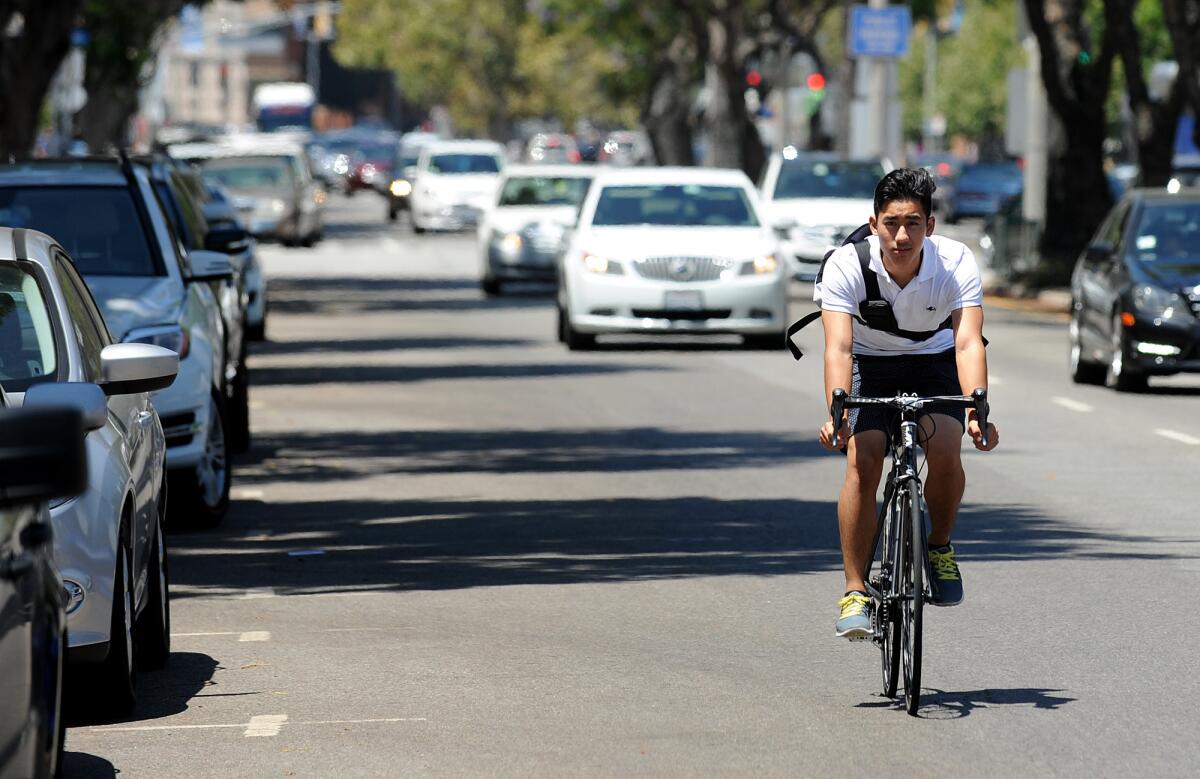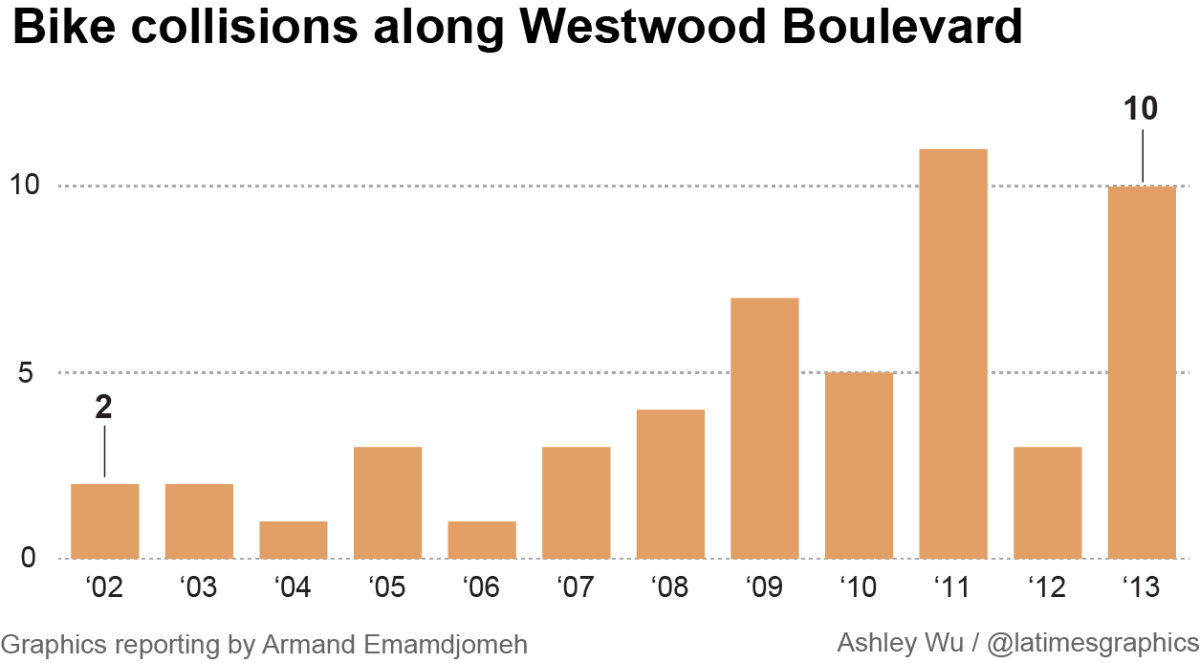California Commute: Westwood bike lane proposal ignites strong feelings on both sides

- Share via
Out on the traffic-choked Westside where cars are king, a proposal to add bicycle lanes to busy Westwood Boulevard is pitting defenders of the status quo against advocates of a greener mode of transportation.
In favor of lanes running south from UCLA are environmentalists, students, transportation experts, public health professionals and the Los Angeles County Bicycle Coalition. Even L.A.'s long-term mobility plan, now going through the approval process, calls for them.
On the opposing side are neighborhood associations, business owners and their political ally, Los Angeles City Councilman Paul Koretz, whose district includes Westwood and UCLA, an enormous generator of bicycle trips.
For months, the opponents have waged a campaign to scrap the proposed lanes and strip them out of the bicycle portion of Mobility Plan 2035.
Koretz and the others contend the addition of marked bike corridors would slow traffic, hinder emergency vehicles, hurt business and endanger hundreds of cyclists who ride daily on the heavily traveled north-south thoroughfare.
The wishes of a tiny minority of commuters, they say, should not take priority over an overwhelming majority of motorists.
"If Westwood Boulevard were to remain in the plan," Koretz said, "the area will lose crucially necessary parking and turn lanes. Traffic will be obstructed and safety will also be risked."
The councilman vowed that work will continue to find safer, less disruptive alternative routes — perhaps using nearby Gayley Avenue or Sepulveda Boulevard — to make sure cyclists have access to UCLA and Westwood's neighborhoods.
The opponents lost Round One at a Los Angeles planning commission meeting in May when the chairman rebuffed the councilman's request to have the bike lanes removed from the mobility plan just before it was approved.
Lane supporters expect Koretz to renew his request in September when the plan is likely to be considered by the council's transportation and planning committees.
According to the mobility plan, the proposed bike lanes would run south from Le Conte Avenue through Westwood Village and across busy Wilshire Boulevard to Wellworth Avenue, and then from Santa Monica Boulevard to just past the Expo Light Rail Line at Exposition Boulevard, where they would intersect with the rail's own bike way. Existing bicycle lanes between Wellworth and Santa Monica would be improved.
The section of Westwood Boulevard from Le Conte to Wilshire has been selected for Mayor Eric Garcetti's Great Streets Initiative, which seeks to make neighborhoods accessible whether visitors arrive by car, bus, bike or on foot.
If the councilman and his allies manage to stop the proposed paths, supporters say, it would leave a large gap in the city's growing network of bike lanes and prevent safety improvements along one of the most dangerous streets in the area for cyclists.
"They want to preserve an auto-centric way of life that is just not sustainable," said Ryan Snyder, a Westwood transportation consultant who has worked on bike-related issues since the late 1970s. "It's hard for me to take when all these people are getting hit out there."
California Highway Patrol figures show that from 2002 through 2013, 52 bicycle accidents were reported along a stretch of Westwood Boulevard between Le Conte and National Avenue, 35 of them blamed on motorists.
Daniella Ward, a graduate student at UCLA and member of the bicycle coalition, said she regularly rides her bike to campus via Westwood Boulevard.
She is one of about 3,100 students, faculty and staff who bike to the sprawling campus daily. UCLA transportation officials estimate that up to 800 of those trips are made on Westwood Boulevard.
"I find Koretz's opposition disappointing," Ward said. "Students are a vulnerable population. They are young and inexperienced. If you don't provide them a safe way to school, that is appalling. I've witnessed so many close calls. There have been some really bad accidents."
Numerous studies in the U.S. have shown that the installation of bike lanes can reduce bicycle accidents by at least 50% in some cases. The lanes reduce encroachments by motor vehicles and also help reduce wrong-way riding, a leading cause of bike accidents and fatalities.
Supporters also say the bike lanes are necessary because local governments in California are under increasing pressure by state laws, such as the Complete Streets Act of 2008, to reduce greenhouse gas emissions and consider alternatives to motor vehicles.
Much of the Westwood Boulevard debate has centered on whether the bike lanes can be added without increasing traffic congestion or reducing safety.
Transportation consultant Snyder, who designed several options for the bicycle coalition, said bike ways can be installed without eliminating any of Westwood's four traffic lanes, parking spaces or room for emergency vehicles.
One option calls for 6-foot-wide bike lanes on each side, which, he says, would reduce the width of the traffic lanes to 10 and 11 feet, a common width for surface street lanes across the city and county. Now, one lane is about 11 feet wide and the other is about 18 feet.
"Koretz wants to protect parking and existing traffic lanes," Snyder said. "Under my plan, there is no skin off anyone's nose. Why would people oppose this? It does not take anything away from anybody."
But opponents question the use of narrower lanes on a major thoroughfare where transit buses, trucks and automobiles make upward of 35,000 trips a day.
They cite the mobility plan's own environmental impact report, which states that bike lanes, including Westwood's, would have "potentially significant" adverse impacts on traffic congestion and emergency response times across the city. The analysis assumes that installing bike lanes would remove traffic lanes, though the report acknowledges that would not always be the case.
"The denser the traffic, the greater the need for wider, not narrower, lanes," said Laura Lake, a longtime community activist and member of the Westwood Community Council. Lake noted that many homeowner associations in the Westwood area and the West Los Angeles Chamber of Commerce oppose the bike lanes.
But other groups have yet to take a position. After a series of community meetings and workshops, the Westwood Village Improvement Assn. asked Koretz and the Los Angeles Department of Transportation in April to do an in-depth study of the bike lane proposal.
Andrew Thomas, executive director of the association, says he has not heard back from the city.
Koretz said he supports a preliminary study as long as the bike lane proposals don't remove traffic lanes, parking or turn pockets.
Follow @LADeadline16 on Twitter for aviation and transportation news
Sign up for Essential California
The most important California stories and recommendations in your inbox every morning.
You may occasionally receive promotional content from the Los Angeles Times.









